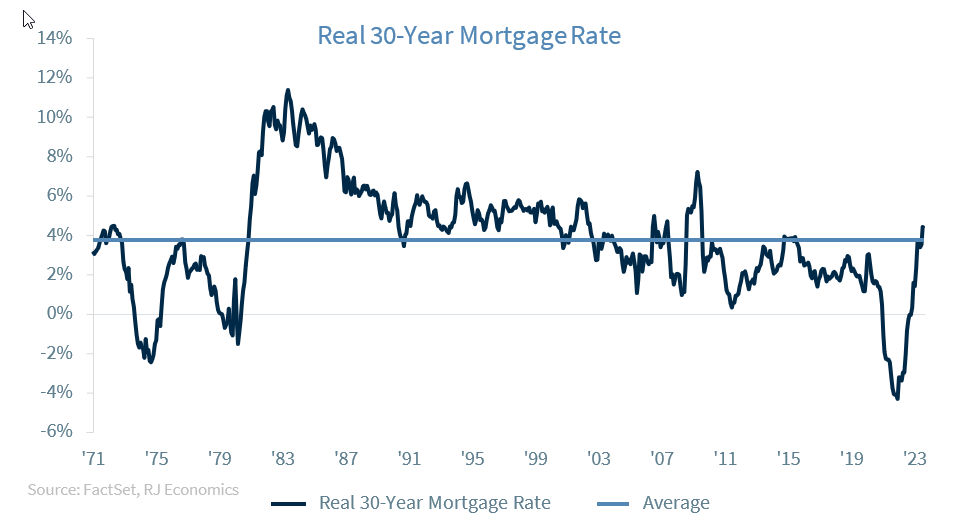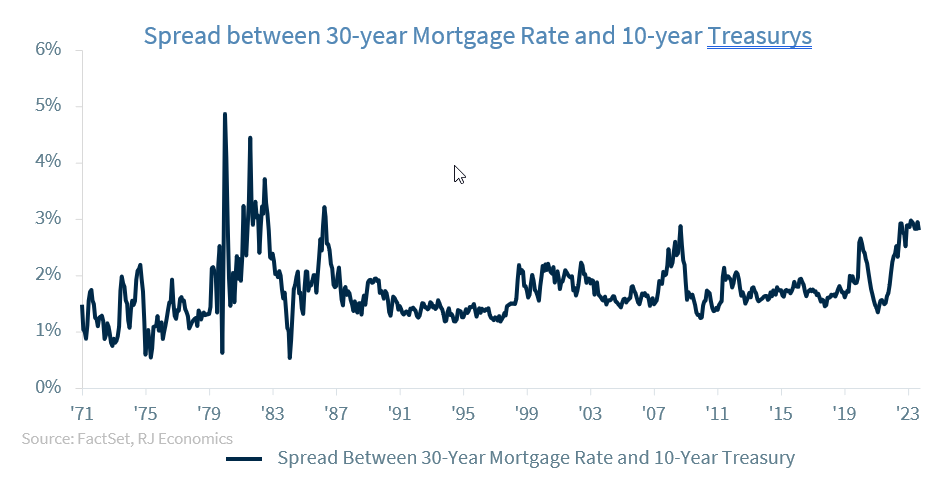Chief Economist Eugenio J. Alemán discusses current economic conditions.
The Federal Reserve (Fed) left the door so wide open after the end of the Federal Open Market Committee (FOMC) meeting in mid-December 2023, that markets have run ahead and have continued to push long-term rates lower since the decision was announced. Although 10-year Treasury yields have rebounded somewhat since then and are back above 4% today, they are much lower than they were late in 2023 when they closed in on 5%.
Thus, markets ‘untightened’ monetary policy at the end of 2023 without any nominal change to the federal funds rate by the Fed. However, if we look at the real interest rate, tightening is still occurring even though we expect the Fed to remain put for the next five months. Inflation has moved lower at a faster pace than originally estimated, which means that the real federal funds rate has continued to increase.
In the graph above we have a historical view of the real federal funds rate plus our forecast that goes to the end of 2025. The average real federal funds rate during the historical period gives us a value of about 1.0%. By November of 2023, the real federal funds rate was at about 2.2%, which is a little more than twice the historical average. However, as the graph shows, the variability in the real federal funds rate over history is very wide and today’s real federal funds rate doesn’t seem too high in this context. Furthermore, since the economy has continued to expand above potential, it is difficult to argue that monetary tightening has had a meaningful impact on economic activity, at least until today.
Having said this, not every sector experiences monetary tightening the same way within the U.S. economy. One of the most sensitive sectors to higher interest rates in the U.S. economy has always been the housing market. In this arena, the increase in the federal funds rate as well as Quantitative Tightening (QT) has produced a meaningful tightening in the market for mortgages over the last several years even though mortgage rates are still relatively low compared to the period 1980-2000, as the graph below shows.
Some of the tightening in the U.S. housing market is coming from the increase in the federal funds rate as it affects the yield on the 10-year Treasury, but the other part is coming from QT, which has produced an important increase in the spread between the 30-year mortgage rate and the yield on the 10-year Treasury as the graph below clearly shows.
Changes to our federal funds rate expectation
The dovish tone coming out of the last Federal Open Market Committee (FOMC), the pressure from markets and the continuation of the disinflationary process have convinced us that Fed officials may be willing to lower interest rates more than three times this year. Thus, we are adding another 25 basis point (bps) decline in the federal funds rate to our current 75 bps of cuts. This means that we now see the Fed cutting the federal funds rate in June (versus July in our previous forecast) by 25 bps, then another 25 bps cut in July, September and December of 2024, for a total of 100 bps for the year.
Economic and market conditions are subject to change.
Opinions are those of Investment Strategy and not necessarily those of Raymond James and are subject to change without notice. The information has been obtained from sources considered to be reliable, but we do not guarantee that the foregoing material is accurate or complete. There is no assurance any of the trends mentioned will continue or forecasts will occur. Last performance may not be indicative of future results.
Consumer Price Index is a measure of inflation compiled by the US Bureau of Labor Statistics. Currencies investing is generally considered speculative because of the significant potential for investment loss. Their markets are likely to be volatile and there may be sharp price fluctuations even during periods when prices overall are rising.
Consumer Sentiment is a consumer confidence index published monthly by the University of Michigan. The index is normalized to have a value of 100 in the first quarter of 1966. Each month at least 500 telephone interviews are conducted of a contiguous United States sample.
Personal Consumption Expenditures Price Index (PCE): The PCE is a measure of the prices that people living in the United States, or those buying on their behalf, pay for goods and services. The change in the PCE price index is known for capturing inflation (or deflation) across a wide range of consumer expenses and reflecting changes in consumer behavior.
The Consumer Confidence Index (CCI) is a survey, administered by The Conference Board, that measures how optimistic or pessimistic consumers are regarding their expected financial situation. A value above 100 signals a boost in the consumers’ confidence towards the future economic situation, as a consequence of which they are less prone to save, and more inclined to consume. The opposite applies to values under 100.
Certified Financial Planner Board of Standards Inc. owns the certification marks CFP®, CERTIFIED FINANCIAL PLANNER™, CFP® (with plaque design) and CFP® (with flame design) in the U.S., which it awards to individuals who successfully complete CFP Board’s initial and ongoing certification requirements.
Links are being provided for information purposes only. Raymond James is not affiliated with and does not endorse, authorize or sponsor any of the listed websites or their respective sponsors. Raymond James is not responsible for the content of any website or the collection or use of information regarding any website’s users and/or members.
GDP Price Index: A measure of inflation in the prices of goods and services produced in the United States. The gross domestic product price index includes the prices of U.S. goods and services exported to other countries. The prices that Americans pay for imports aren’t part of this index.
The Conference Board Leading Economic Index: Intended to forecast future economic activity, it is calculated from the values of ten key variables.
The Conference Board Coincident Economic Index: An index published by the Conference Board that provides a broad-based measurement of current economic conditions.
The Conference Board lagging Economic Index: an index published monthly by the Conference Board, used to confirm and assess the direction of the economy’s movements over recent months.
The U.S. Dollar Index is an index of the value of the United States dollar relative to a basket of foreign currencies, often referred to as a basket of U.S. trade partners’ currencies. The Index goes up when the U.S. dollar gains “strength” when compared to other currencies.
The FHFA House Price Index (FHFA HPI®) is a comprehensive collection of public, freely available house price indexes that measure changes in single-family home values based on data from all 50 states and over 400 American cities that extend back to the mid-1970s.
Import Price Index: The import price index measure price changes in goods or services purchased from abroad by U.S. residents (imports) and sold to foreign buyers (exports). The indexes are updated once a month by the Bureau of Labor Statistics (BLS) International Price Program (IPP).
ISM New Orders Index: ISM New Order Index shows the number of new orders from customers of manufacturing firms reported by survey respondents compared to the previous month. ISM Employment Index: The ISM Manufacturing Employment Index is a component of the Manufacturing Purchasing Managers Index and reflects employment changes from industrial companies.
ISM Inventories Index: The ISM manufacturing index is a composite index that gives equal weighting to new orders, production, employment, supplier deliveries, and inventories.
ISM Production Index: The ISM manufacturing index or PMI measures the change in production levels across the U.S. economy from month to month.
ISM Services PMI Index: The Institute of Supply Management (ISM) Non-Manufacturing Purchasing Managers’ Index (PMI) (also known as the ISM Services PMI) report on Business, a composite index is calculated as an indicator of the overall economic condition for the non-manufacturing sector.
Consumer Price Index (CPI) A consumer price index is a price index, the price of a weighted average market basket of consumer goods and services purchased by households. Changes in measured CPI track changes in prices over time.
Producer Price Index: A producer price index (PPI) is a price index that measures the average changes in prices received by domestic producers for their output.
Industrial production: Industrial production is a measure of output of the industrial sector of the economy. The industrial sector includes manufacturing, mining, and utilities. Although these sectors contribute only a small portion of gross domestic product, they are highly sensitive to interest rates and consumer demand.
The NAHB/Wells Fargo Housing Opportunity Index (HOI) for a given area is defined as the share of homes sold in that area that would have been affordable to a family earning the local median income, based on standard mortgage underwriting criteria.
The S&P CoreLogic Case-Shiller U.S. National Home Price NSA Index measures the change in the value of the U.S. residential housing market by tracking the purchase prices of single-family homes.
The S&P CoreLogic Case-Shiller 20-City Composite Home Price NSA Index seeks to measures the value of residential real estate in 20 major U.S. metropolitan.
Source: FactSet, data as of 7/7/2023
Markets & Investing Members of the Raymond James Investment Strategy Committee share their views on...
Markets & Investing Review the latest Weekly Headings by CIO Larry Adam. Key Takeaways ...
Technology & Innovation Learn about a few simple things you can do to protect your personal information...


